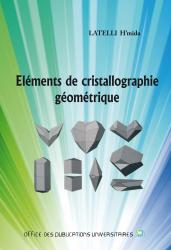- معلم: salah blizak
مقياس السداسي الاول الفيزياء الاحصائية للسنة الاولى ماستر
- معلم: Rabah BACHIRI
Ce cours est destiné aux étudiants du 1ère année master
Physique des matériaux au semestre 1
Diffusion dans les Solides (Diffusion in Solids)
This module delves into the fundamental concept of diffusion within solid materials, encompassing three main chapters:
1. Introduction to Diffusion Phenomena:
- Overview of diffusion processes in solids.
- Introduction to the concept of particle movement and mass transfer within materials.
2. Atomic and Molecular Diffusion:
- In-depth exploration of atomic and molecular diffusion mechanisms.
- Understanding the role of temperature, pressure, and concentration gradients in diffusion.
3. Impurities and Dopants Diffusion:
- Study of the diffusion of impurities and dopants in solid materials.
- Implications for material properties and applications in semiconductor devices.
Objectives:
- Understand the principles of diffusion in solid materials, including atomic and molecular diffusion.
- Analyze diffusion processes in crystalline structures and their impact on material properties.
- Explore the diffusion of impurities and dopants and its applications in material engineering.
- Develop problem-solving skills and apply diffusion concepts to real-world scenarios.
Summary:
The "Diffusion dans les Solides" module aims to provide students with a comprehensive understanding of diffusion phenomena within solid materials. From the basic principles of particle movement to the intricacies of diffusion in crystalline structures and the implications of impurity diffusion, students will gain valuable insights into the behavior of materials. The module emphasizes practical applications and problem-solving skills, preparing students to apply diffusion concepts in various scientific and engineering contexts.
الانتشار في الصلب (Diffusion dans les Solides)
تركز هذه الوحدة على مفهوم الانتشار الأساسي داخل المواد الصلبة، مع تضمين ثلاثة فصول رئيسية:
1. مقدمة في ظواهر الانتشار:
2. الانتشار الذري والجزيئي:
3. انتشار الشوائب والملوثات:
الأهداف:
- فهم مبادئ الانتشار في المواد الصلبة، بما في ذلك الانتشار الذري والجزيئي.
- تحليل عمليات الانتشار في الهياكل البلورية وتأثيرها على خصائص المواد.
- استكشاف انتشار الشوائب والملوثات وتطبيقاتها في هندسة المواد.
- تطوير مهارات حل المشكلات وتطبيق مفاهيم الانتشار في سياقات العمل الحقيقية.
الملخص:
تهدف وحدة "Diffusion dans les Solides" إلى تزويد الطلاب بفهم شامل لظواهر الانتشار داخل المواد الصلبة. من المبادئ الأساسية لحركة الجزيئات إلى تفاصيل الانتشار في الهياكل البلورية ، سيحصل الطلاب على رؤى قيمة حول سلوك المواد. تشدد الوحدة على التطبيقات العملية ومهارات حل المشكلات، مما يُعد الطلاب لتطبيق مفاهيم الانتشار في سياقات علمية وهندسية متنوعة.
- معلم: Mustapha BOUCENNA
 www.opu-dz.com |
|
|---|
ACADEMIC WRITING
1- Writing an essay
*An essay is a "short formal piece of writing...dealing with a single subject" ("Essay," 2001).
*It is typically written to try to persuade the reader using selected research evidence ("Essay," 1997).
* In general, an academic essay has three parts:
- An introduction that gives the reader an idea of what they are about to learn and presents an argument in the form of a thesis statement.
- A body, or middle section, that provides evidence used to prove and persuade the reader to accept the writer's particular point of view.
- A conclusion that summarizes the content and findings of the essay
- معلم: Zoulikha CHERIFI

